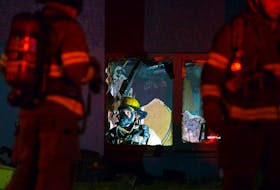City staff spelled out to Halifax Regional Council why a proposed pilot project to install surveillance cameras in the area of the Farrell Street pathway where Chelsie Probert was killed is not recommended to proceed.
Amy Siciliano, public safety adviser for the municipality, told council that staff research indicated the cameras would not be the best measure to prevent crime in the area, instead pointing out the impact other measures would have such as cleaning the area, reducing foliage, installing benches or similar infrastructure and better lighting.
The item was brought to regional council’s agenda as an information item by Deputy Mayor Tony Mancini, who spearheaded the initial request for staff to look into the addition of CCTV, or closed circuit television, after the tragic death.
“Overall, it’s a tough subject,” Mancini said during a break in the council session. “Chelsie was only 18 years old at the time, the same age as my daughter, and I met the family.”
A now-17-year-old young offender was found guilty in January of manslaughter in Probert’s killing. During his trial, it came out that the teen, who cannot be identified because of his age, and another young man, who testified against the offender, were in the area looking to rob someone when Probert was stabbed to death.
“It had a huge impact on the community, that homicide” Mancini said. “We’re happy to see someone being convicted and being sentenced as we speak, so my request for looking at cameras was in response to that.”
The subsequent staff report highlighted the alternative measures suggested after a Crime Prevention Through Environmental Design audit.
“Would (cameras) have prevented that crime from taking place?” Mancini mused. “All the reports indicate not necessarily. Most likely not. Would it have helped with the investigation? Yes. It really turns out that we did a lot of things on the CPTED audit, which is the audit the police does, on the pathway we cleaned that up, made it safer. … The surrounding park, we reached out to Nova Scotia Power because they own that land. And I asked them, I said ‘the police tell us they’re chasing the bad guys and that’s where they go because they can get lost in the bush.’ Plus there was mattresses and condoms and needles in there and we would try to clean it up and still never got it done so Nova Scotia Power cleaned it up. They went in there and they literally cut all the brush back. Then they allowed us, the municipality, to create a pathway and then Nova Scotia Power has lit the pathway extensively.
“So now this is a wonderful space the community has embraced and residents are telling me they feel safe there now. So they’re safe on the pathway, they’re safe in the park.”
Mancini pointed out there was no motion on the floor at the council session. It’s no longer council’s purview to make the decision, anyway. An administrative order passed last August governs how staff assess and ultimately decide where a camera installation would be warranted and effective.
Siciliano said there’s little evidence that cameras deter impulse crimes.
Cameras work in preventing things like property crime, vandalism, and vehicle thefts in combination with “a suite” of other measures, such as good lighting, comprehensive coverage areas and the potential offender knowing the cameras are there, Siciliano said.
There are areas where staff are considering cameras as appropriate measures.
“Right now I’m working with folks in the Prestons on an illegal dumping site that’s known as the connector road, it’s Upper Governor Street,” she said after her presentation to council. “There’s a very big issue with illegal dumping in that area and so we’re working with partners which include Transportation and Public Works, solid waste, the RCMP, residents, the councillor, on a prevention and enforcement strategy there, so cameras are being considered and there is evidence to show that that type of crime, illegal dumping in a contained space, it’s a long road, could prevent that from happening. The challenge there is technological. There’s no power, there’s no lights, so those are things technically that we have to work through ...”
Halifax Regional Police superintendent Don MacLean said there were no reports of crime on that Farrell Street pathway since Probert’s death.
“That doesn’t mean there hasn’t been patrols or there hasn’t been that sort of activity but we’re talking about reported police incidents, there has been no specific incident within that small geographical area where the camera was intended to be placed,” MacLean said.
In a session set for late Tuesday night, council was expected to finally ratify the comprehensive Centre Plan to govern development in the future.
RELATED:








